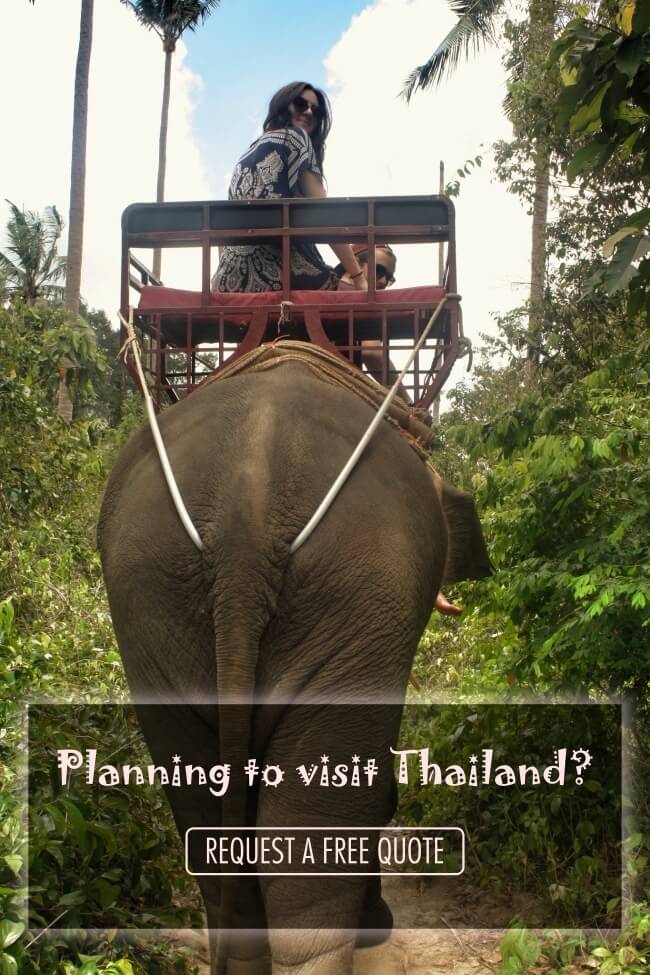Peppered with a wealth of natural and historical attractions, Kanchanaburi features a host of sightseeing opportunities no matter where you go. World War II memories have a prominent presence in the city area, with a number of museums and war memorials dedicated to the many lives lost during the Japanese occupation. But a trip to Kanchanaburi can certainly be more than a war remembrance, as it offers an endless number of recreations and natural excursions. Erawan National Park, with picturesque waterfalls and caves, offers a delightful escape closer to the city centre. Thong Pha Phoom is an oasis filled with natural wonders. Discover a range of experiences from natural hot springs to waterfalls to mountain-hugged water reservoirs and an abandoned mine with a scenic viewpoint of the verdant landscapes around the Thai-Burmese border. Further northwest is Sangklaburi, a wild jungle town with untouched rural life and a pleasant down-to-earth vibe.
Bridge over the River Kwai (Kwae)
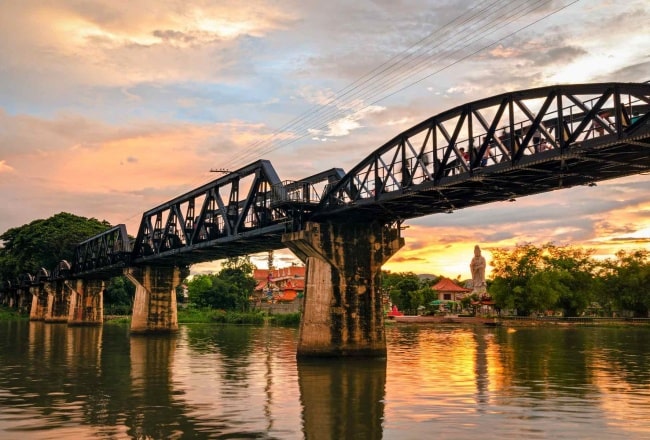
This reconstructed iron-rail bridge has become the immortal symbol of the Death Railway’s 414-km stretch. Linking the two sides of the Kwai Yai River, the bridge is perhaps the most photographed landmark in Kanchanaburi and has attracted travellers from all corners of the world. The one standing today is actually a reconstruction of the original bridge built by the Allied POWs under the Japanese army, which was bombed and destroyed in 1945 after being in use for 20 months.
Set against a scenic backdrop of the river, the bridge is still used today. You can walk on it and cross over to the other side of the river, but be careful of trains (twice a day) and motorcycles sharing the narrow path. It’s a good idea to drop by the JEATH War Museum before you actually head to the bridge, to learn about its history and stories behind the construction of the Death Railway.
Location: Mae Nam Kwae Road
Death Railway
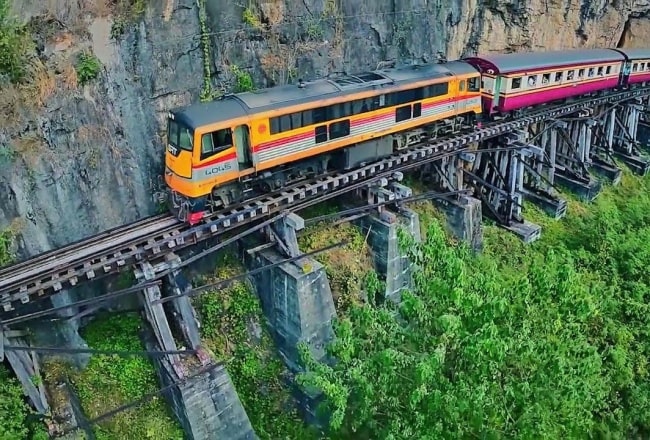
Stretching 414km across western Thailand and into Burma, the Death Railway is a standing testimonial of a story that many wish had never happened. Started in 1942 by Allied POWs, under the orders of the Japanese army, the construction was finished 16 months later, three years and eight months short of the original timeframe. It cut through some of the most rugged terrains – limestone cliffs and craggy mountains – resulting in over 100,000 deaths due to sickness, malnutrition and exhaustion. This rail route linked Thailand’s Ban Pong (Ratchaburi) with Thanbuyuzayat, Burma, to carry supplies across into India.
You can trace the Death Railway route by hopping on the train at Tha Kilen Station (near Prasat Muang Singh) to the terminal station at Nam Tok (Sai Yok Noi Waterfall). This 77-km section passes through the most beautiful section of the Death Railway – as it crosses over the wooden viaduct hugging the cave-ridden cliff – and some of the most picturesque countryside in the country. The journey takes two hours.
Location: Kanchanaburi City to Sai Yok
Erawan Waterfall
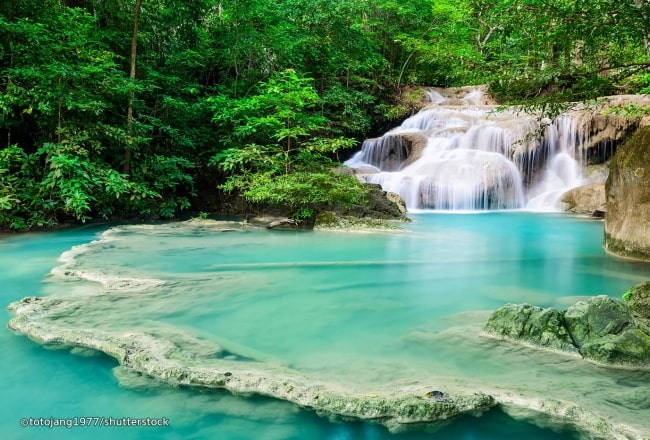
Erawan Waterfall is recognized as one of the most beautiful waterfalls in Thailand. Located in the Tenasserim Hills in Kanchanaburi Province, some 200 km northwest of Bangkok, Erawan has seven separate tiers and is part of a national park of the same name. Besides the waterfall, the park hosts a handful of limestone caves offering plenty of exploration opportunities to visitors.
The entire length of the seven tiers span approximately 1,500 m through the thick rainforest of the park. Each of the steps has its own name. The access to the first waterfall – named Hlai Keun Lung, is relatively easy, as you can get there on a flat trail, directly from the visitor centre’s car park. The highlight of this first waterfall is the great number of fish swimming in the ponds formed by the smooth limestone sculpted by the water. The fish are rather curious and will swim around your legs. It can be disconcerting at first but you soon get used to it.
Opening Hours: 07:00 – 16:30
Location: at Erawan National Park, some 200 km northwest of Bangkok
Hellfire Pass Memorial
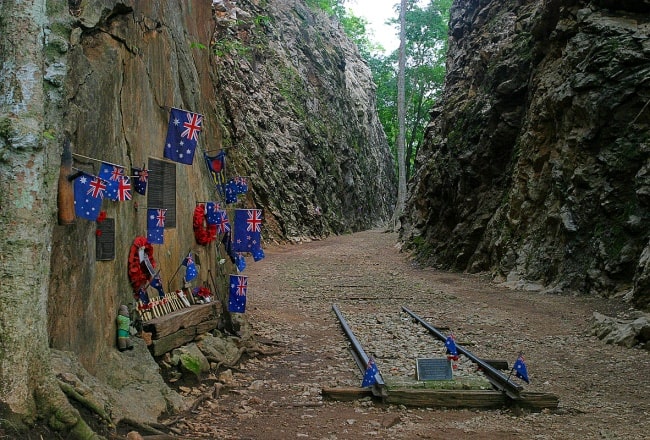
Put your experience of the Death Railway in perspective by heading over to Hellfire Pass Memorial. This 500-metre long, 26-metre deep cut through solid boulders is notorious for claiming the most lives. In the 12 weeks of construction, 700 out of 1,000 Australian and British soldiers died. Walking down the old jungle-fringed railway track on the way to Hellfire Pass and Museum, the deafening silence envelopes you. Visit the museum, co-sponsored by the Australian and Thai governments, and learn the moving stories of those whose lives were lost in what is deemed to be one of the darkest pages in World War II history.
Opening Hours: 09:00 – 16:00 daily (museum)
Location: On Highway 323, between Sai Yok and Thong Pha Phoom Districts
JEATH War Museum
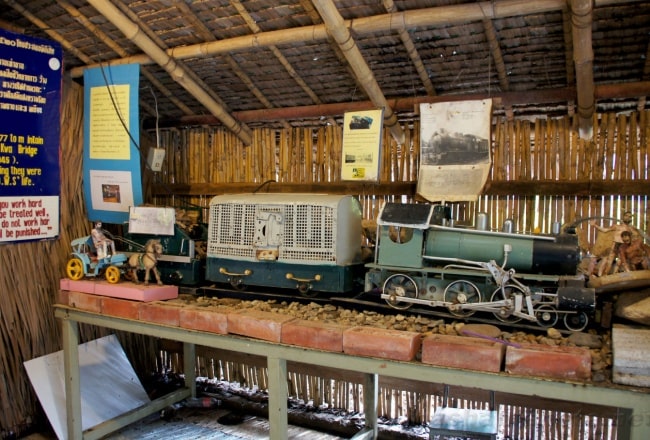
Before heading over to the Bridge over the River Kwae, it’s a good idea to stop by this museum first for a bit of history and stories behind the construction of the infamous Death Railway. The museum is housed inside the exact replica of the Prisoners of War’s bamboo huts, built on the original site of the first wooden bridge across the river.
The dark, cramped interiors display a collection of photographs from the days when the construction took place (1942-1943) and the living conditions that the POWs were forced to endure, accompanied by real accounts of the event by the POWs themselves as well as their relatives, friends and writers of that time. These stories help bring a context to the scene where the reconstructed bridge now stands, and you will appreciate the sight a little more, rather than just say ‘oh, it’s a bridge’ like those who haven’t taken the time to learn the history.
Location: Inside Chai Chumphon Temple, about two km south of the Bridge over the River Kwae on Pak Praek Road by the river (near the TAT office on Saeng Chuto Road)
Kanchanaburi Allied War Cemetery (Don Rak)
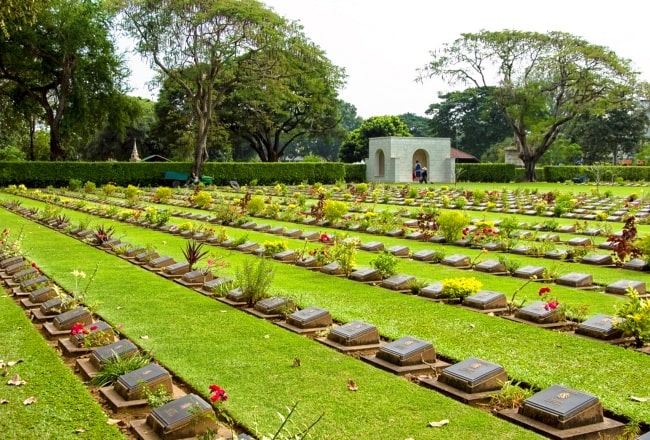
Amidst the sound of traffic and ongoing life is the final resting place of those who lost their lives during the construction of the Death Railway. The second you step inside, complete silence pervades. The name plaques of nearly 7,000 Allied POWs are spread neatly across the cemetery’s landscaped grounds. Out of some 100,000 labourers who died during the construction of the Death Railway, 16,000 were Allied POWs, the rest were Thai and Asian forced labourers. Smaller and less visited, the Chung Kai Allied War Memorial (across the river, three km south of the Bridge over the River Kwai) houses the graves of 1,740 Allied POWs. Both are maintained by volunteers.
Opening Hours: Daily
Location: Saeng Chuto Road, opposite train station
Prasat Muang Singh Historical Park
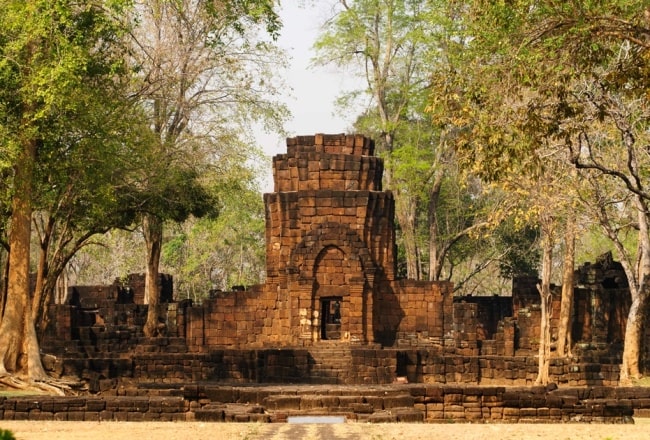
A cultural highlight not far from the city centre, this popular archaeological site features four 13th-Century Khmer-style ruins and an ancient human burial site. The main ruin is an ancient temple built from laterite stones and set on a rectangular base, with a corn-shaped prang standing at its epicentre. The temple is surrounded by four cloister walls and four entrance gates with stone-carved lintels. Archaeological evidence suggests heavy Khmer influences in the area and that the temple was built as a place of worship for Mahayana Buddhists.
Strolling around the grounds of Prasat Muang Singh can be extremely hot, as there are few shaded areas where you can take a rest. However you can rent a bicycle and explore the ruin site on two wheels. Enjoy the beautiful panoramas of the Kwae Noi River from the front of the temple.
Opening Hours: 09:00 – 16:30 daily
Location: Sai Yok District, about 43km. from Kanchanaburi
Sai Yok National Park

At the end of the Death Railway’s 77-km line, another journey begins. From Kanchanaburi City, the railroad track runs along the Kwae Noi River, passing through the ‘deadly curve’ – believed to be the most scenic section of the Death Railway – before culminating at the Nam Tok (Waterfall) Terminal Station, where Sai Yok Noi Waterfall is located. North of Sai Yok Noi, along the old rail route, explore a range of attractions that together comprise Sai Yok National Park, including Sai Yok Yai Waterfall, Lawa Cave, Daowadueng Cave, Kaew Cave and Hellfire Pass Memorial.
Location: At the end of the Death Railway line (Nam Tok Terminal Station)
Tiger Temple (Wat Pa Luang Ta Bua)
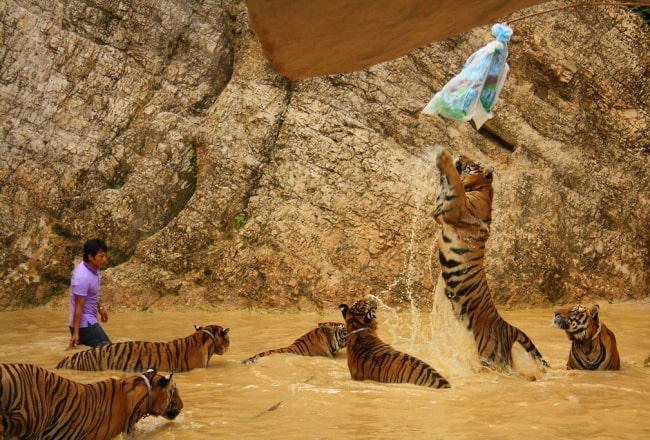
This controversial landmark has garnered fame amongst an international crowd. Known for its thriving tiger sanctuary, Tiger Temple shelters more than 60 Indochinese tigers and cubs on its ground. After paying a hefty entrance fee, you can watch the tigers going about their daily routine from a distance. There are also several photo opportunities with the tigers. To get real close to them though, you will be required to pay a higher fee.
For the curious mind, a visit to this temple may prove to be an interesting experience. Many travellers, however, walk away feeling ‘ashamed’, as the tigers, they say, ‘appear drugged’ and unresponsive. So, it’s up to you to decide whether or not to support this religious establishment’s ‘wildlife conservation’ activity.
Opening Hours: 10:00 – 16:30
Location: On Highway 323, about 38km from Kanchanaburi City
Wat Tham Khao Noi
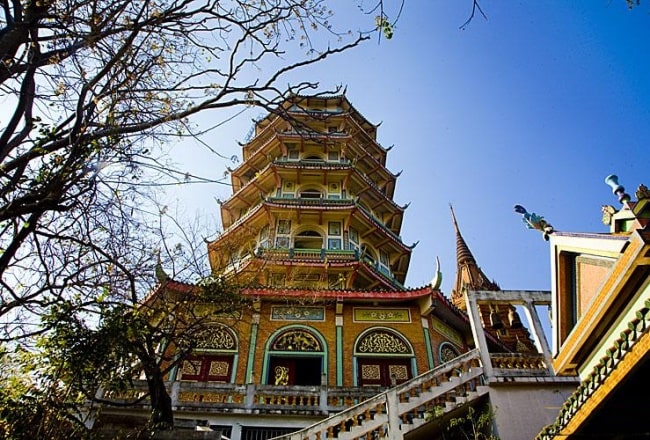
Sharing the same hilltop location with Wat Tham Sua, Wat Tham Khao Noi has a towering multi-tier Chinese-style pagoda and intricate sculptural details. The temple was built by a Chinese abbot in 1883 and has been a place of worship for Mahayana Buddhists since. Inside the monastery, the principal Buddha image sits alongside Chinese dieties. This theme continues as you ascend the spiral staircase to the seven-tiered centre piece pagoda, which embodies the concept of the seven levels in heaven. From the top of the hill, look out to an all-encompassing view of the countryside as well as the adjacent Wat Tham Sua.
Location: Tha Muang District, 5km from Mae Klong Dam
Wat Tham Sua
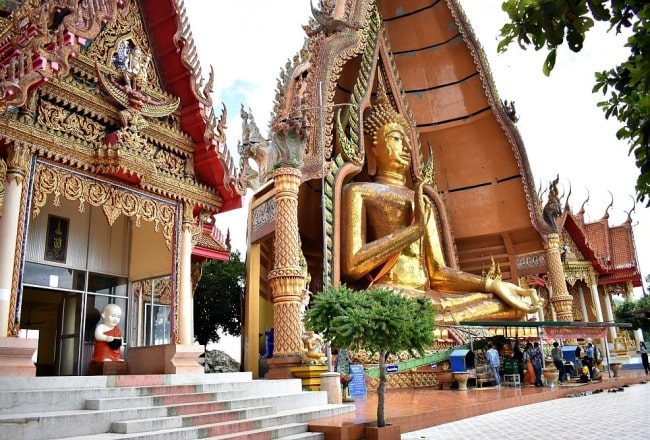
Not to be confused with the Tiger Temple (Wat Pa Luang Ta Bua), Wat Them Sua (Tiger Cave Temple) is an architectural wonder. The temple is set atop a hill, fronting the Mae Klong Dam and backed by a vast expanse of rice fields.
Climb up 157 steep steps to get to the top, where the giant golden Buddha image rests inside a semi-circular ‘aura’ dome. The main chapel features ornate, multi-tier gables and door arches, built on an octagonal base – a peculiar layout only found at this temple. Another highlight is the ‘Ket Kaew’ pagoda, featuring multiple built-in niches along its polygonal sides. Sharing the same hilltop but not directly accessed from Wat Tham Sua is Wat Tham Khao Noi. From afar, this ‘temple hill’ looks simply stunning.
Location: Tha Muang District, five km from Mae Klong Dam





























